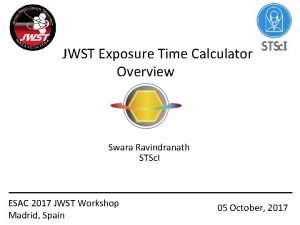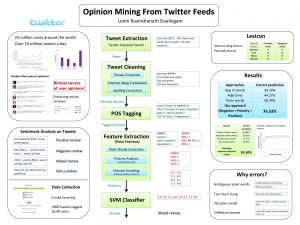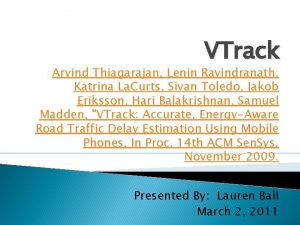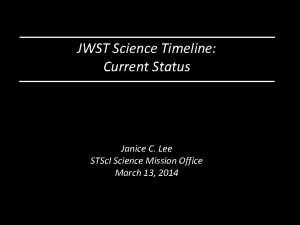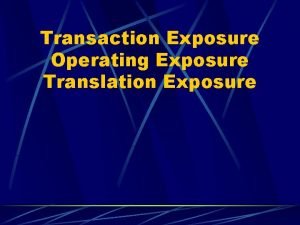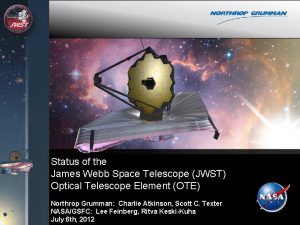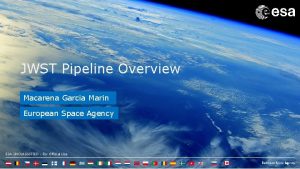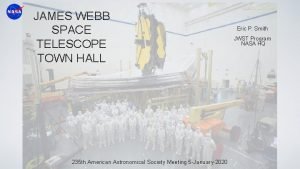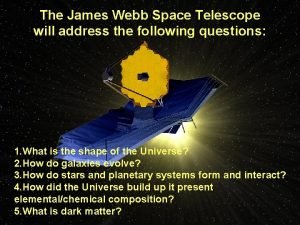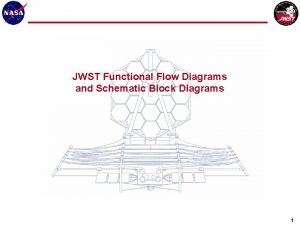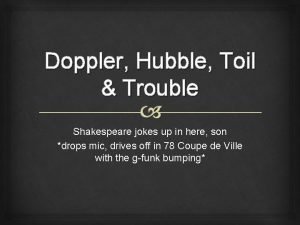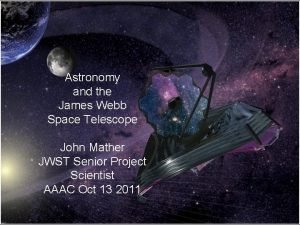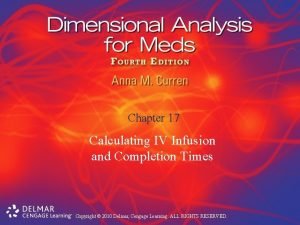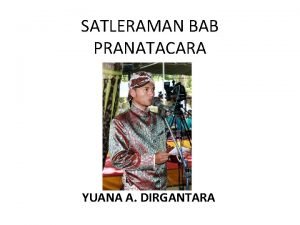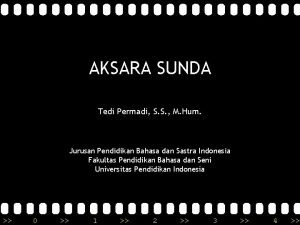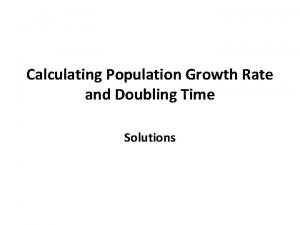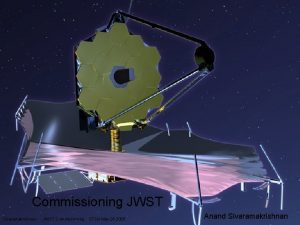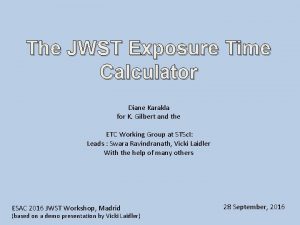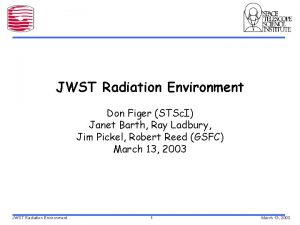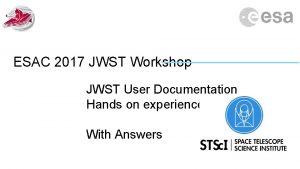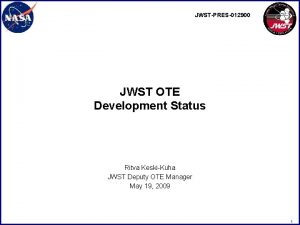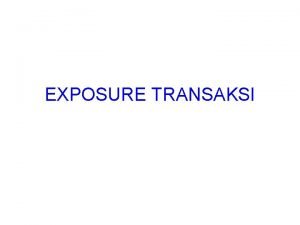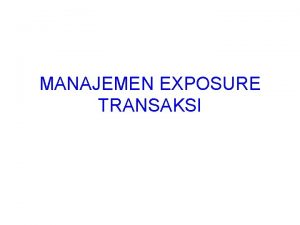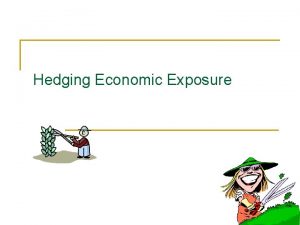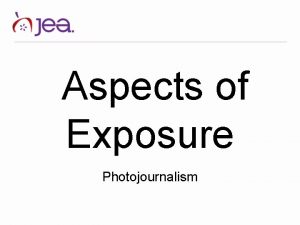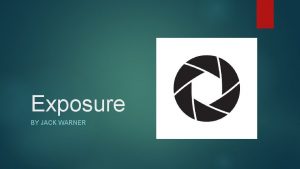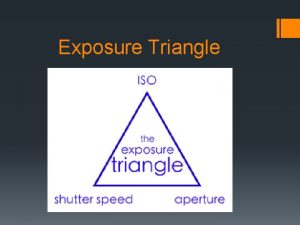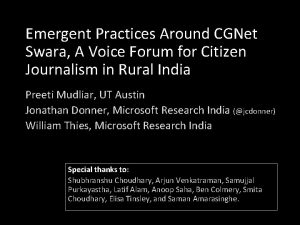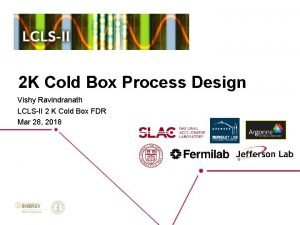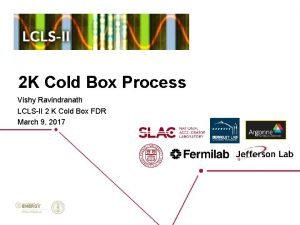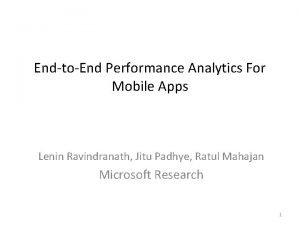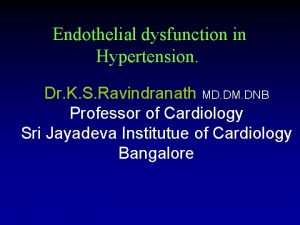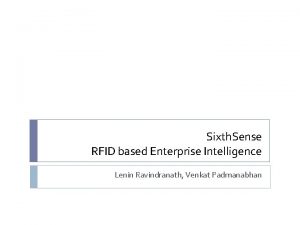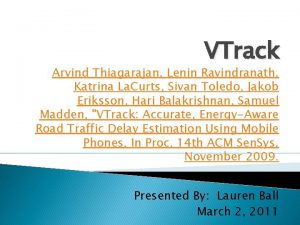JWST Exposure Time Calculator Overview Swara Ravindranath STSc


























- Slides: 26

JWST Exposure Time Calculator Overview Swara Ravindranath STSc. I ESAC 2017 JWST Workshop Madrid, Spain 05 October, 2017

JWST ETC: Introduction • Originally, it was envisioned that JWST ETC would be similar to the HST ETC • Basic design of HST ETC found not viable for advanced observing modes of JWST, and to handle JWST detector noise properties and readout patterns • New features required to support modern user interaction and collaborations Imaging NIRCam SW+LW NIRISS MIRI NIRSpec TA (through MSA mesh) Slit spectroscopy NIRSpec FS MIRI LRS IFU spectroscopy NIRSpec IFU MIRI MRS Multi-object spectroscopy NIRSpec MSA Slitless spectroscopy NIRISS WFSS NIRISS SOSS MIRI LRS Coronagraphy NIRCam spots + wedges MIRI Lyot MIRI FQPMs Aperture Masking Interferometry NIRISS AMI Reference: JWST Community Lecture Series - Pandeia: the JWST Exposure Time Calculator (Klaus Pontoppidan)

JWST ETC: Recommendations • ETC should use 3 -dimensional (2 spatial + 1 spectral) framework • ETC should use a PSF library, such as generated by the Webb. PSF tool • Noise propagation should include correlated noise • Post-observation additions of multiple exposure, background subtraction, extraction of photometry and spectroscopy should be explicitly modeled under unifying concept of "observing strategy" • ETC should be sufficiently fast to support efficient comparative parameter studies, as well as inverse problems • ETC should be template-based for all 3 main inputs (instrument config. , target design, observing strategy) Reference: JWST Community Lecture Series - Pandeia: the JWST Exposure Time Calculator (Klaus Pontoppidan)

The Pandeia Project : JWST ETC engine Python library JWST reference database Throughputs noise properties PSFs Web application @ jwst. etc. stsci. edu JWST Background Model User interface for users of the ETC collaborative functionality Currently only available through the web application Reference: Pontoppidan, K. M. , et al. 2016, Proceedings of SPIE 9910, Observatory Operations: Strategies, Processes, and Systems VI, 991076; (ar. Xiv: 1707. 02202)

JWST ETC: ETC Engine • JWST code project called "Pandeia", has generality to use with any observatory with appropriate configuration files and reference data. • Under the hood: 3 D sensitivity engine • Includes PSFs, correlated noise and detector effects, effects of background subtraction and extraction • Pointing and time dependent JWST background model Reference: Pontoppidan, K. M. , et al. 2016, Proceedings of SPIE 9910, Observatory Operations: Strategies, Processes, and Systems VI, 991076; (ar. Xiv: 1707. 02202)

JWST ETC: Engine algorithm Scenes build at each wavelength, and convolved with PSFs Slitted Spectroscopy Imaging projection Slitless Spectroscopy Reference: Pontoppidan, K. M. , et al. 2016, Proceedings of SPIE 9910, Observatory Operations: Strategies, Processes, and Systems VI, 991076; (ar. Xiv: 1707. 02202)

JWST ETC: Strategies ETC Strategies specify how and where the SNR has to be computed. The calculation of SNR involves calculating the flux rate and computing the total flux over the selected region with appropriate weighting of the pixels. Total flux Flux per pixel Scalar weight of pixel Variance in the measurement Covariance matrix Reference: Pontoppidan, K. M. , et al. 2016, Proceedings of SPIE 9910, Observatory Operations: Strategies, Processes, and Systems VI, 991076; (ar. Xiv: 1707. 02202)

JWST ETC: Strategies Example: Aperture Photometry A = aperture for source B = background region Pixel weights Reference: Pontoppidan, K. M. , et al. 2016, Proceedings of SPIE 9910, Observatory Operations: Strategies, Processes, and Systems VI, 991076; (ar. Xiv: 1707. 02202)

JWST ETC: PSFs • Uses Webbpsf to compute point spread functions with realistic wavefront errors. • Calculates almost 3000 individual monochromatic PSFs • Subsampled by integer factor of the detector pixel size • The observed PSF depends on the color of the astronomical source. Reference: Pontoppidan, K. M. , et al. 2016, Proceedings of SPIE 9910, Observatory Operations: Strategies, Processes, and Systems VI, 991076; (ar. Xiv: 1707. 02202)

JWST ETC: Backgrounds • JWST ETC uses a dynamic background model generator (BMG) • Zodi + ISM “cirrus” emission (in-field) • Stray light scattered into the FOV • Thermal emission from JWST itself which is the dominant background component at > 15 microns. • Zodi and Galactic emission is calculated for a given RA and Dec in two ways: 1. For a given date: “Dated background” 2. As percentile of the background for those coordinates over the visibility: “Dateless Background” Reference: Pontoppidan, K. M. , et al. 2016, Proceedings of SPIE 9910, Observatory Operations: Strategies, Processes, and Systems VI, 991076; (ar. Xiv: 1707. 02202)

JWST ETC: Web Application • Workbooks: Organize and save your ETC calculations • Build your own re-usable sources and scenes library • Efficiently analyze and compare different instruments and modes • Share ETC calculations and work collaboratively with your team • Download images and plots for detailed analysis

JWST ETC: User Interface https: //jwst. etc. stsci. edu Use My. ST user account (https: //proper. stsci. edu/proper/authentication/auth) Release notes How to open old workbooks Known issues Login with My. ST user account: • Preserves workbook after logout • Helps to recover lost workbooks Anonymous user workbooks are lost after logout or when session is terminated

JWST ETC UI: Key Features Workbooks • Organize and save your ETC calculations • Can contain multiple sources, scenes, and calculations • Are persistent in your My. ST account and shareable • Sample workbooks are provided for all instrument modes

JWST ETC UI: Key Features Reusable Scenes and Sources • Scene is a postage-stamp of the sky, few arcsecs on a side • A scene can have no source, single or multiple sources • Sources and scenes can be defined once, used many times

JWST ETC UI: Key Features Copy and Modify Workflow • Users do not have to start from scratch • Calculations in a workbook start with reasonable defaults • Users can simply copy the calculation, modify inputs as desired, and recalculate • Users can copy and modify Scenes and Sources Copy calculation, copy scene, and copy sources options are in Edit menu

JWST ETC UI: Key Features Upload spectra • Can upload user-supplied spectrum and assign to sources • 2 -column ascii format (wavelength, flux) or FITS files • Uploaded spectrum file must be compatible with Py. Synphot • Uploaded spectra will appear in the "continuum" tab pysynphot as psyn > import > sp = psyn. File. Spectrum(’ 9160_newunits

JWST ETC UI: Key Features Batch Expansion • Duplicate calculation N times varying only selected parameter • Can run multiple calculations by only varying filters • Batch calculations by varying either Ngroups, Nintegrations • Useful to see how SNR changes with exposure specification

JWST ETC UI: Key Features Collaborative work • Workbook sharing is enabled and strongly encouraged • Can assign user access permission to selected workbooks • Shared workbook appears in available workbooks list Select workbook of collaborator • Advice to coordinate with collaborator to avoid accidental clobbering Provide My. ST email address

Scenes and Sources page

Calculations page Calculations table Configuration pane Outputs

JWST ETC Outputs: Images NIRCam Imaging NIRISS WFSS • ETC outputs 2 D SNR and Detector images for different observing modes NIRSpec Fixed Slit NIRSpec IFU • All image products are available for downloads as FITS images for further analysis

JWST ETC Outputs: Images Saturation Map • Color map shows value of 1. 0 for partial saturation and 2 for full saturation. • Partial saturation implies some of the pixels are saturated at the end of a ramp. Partial ramps may still be useful. • Full saturation implies there are pixels that are saturated at the end of the first group and cannot be recovered.

JWST ETC Outputs: Plots • ETC outputs 1 D plots for extracted flux, sky background and SNR for different calculations • All data used for plots are available for downloads as FITS tables for further analysis

JWST ETC : Reports • Report: Calculated scalar values, summary of inputs • Warnings: Information that might affect the accuracy or otherwise influence science decisions • Errors: Information about why the calculation did not complete • Downloads: tar file of intermediate & output products includes - FITS files of 3 D data cube for IFU - 2 D images and spectra - extracted flux, combined backgrounds, and SNR as FITS tables

JWST ETC: Downloads Slitless Spectroscopy of z=3 galaxy with central AGN and outflow Left: NIRISS imaging in F 200 W, F 150 W, F 090 W. Lower Panel: NIRISS WFSS calculation in F 200 W, F 150 W, F 115 W. The F 200 W filter contains the H-alpha emission shown by red color in the image and spectrum. Created from FITS files in ETC Output Downloads. Direct image F 115 W, F 150 W, F 200 W GR 150 R+115 W GR 150 R+150 W GR 150 R+200 W

JWST ETC: Helpful links ETC Documentation: jwst-docs. stsci. edu JWST Help Desk: jwsthelp. stsci. edu
 Jwst etc
Jwst etc Lenin ravindranath sivalingam
Lenin ravindranath sivalingam Lenin ravindranath
Lenin ravindranath Scientist project
Scientist project Managing economic exposure and translation exposure
Managing economic exposure and translation exposure Translation exposure
Translation exposure How to manage economic exposure
How to manage economic exposure Managing economic exposure and translation exposure
Managing economic exposure and translation exposure Jwst status
Jwst status Jwst launch
Jwst launch Macarena garcia marin
Macarena garcia marin Jwst town hall
Jwst town hall Jwst
Jwst Mcc-1a jwst
Mcc-1a jwst Hubble jokes
Hubble jokes Jwst
Jwst Calculating iv infusion rate
Calculating iv infusion rate Pangrenggawara
Pangrenggawara Bagian-bagian pranatacara
Bagian-bagian pranatacara Olah subasita tegese
Olah subasita tegese Pranata gati
Pranata gati Pamingkal aksara sunda
Pamingkal aksara sunda Rtim real time interaction management
Rtim real time interaction management Start time, end time and elapsed time
Start time, end time and elapsed time Www.bmi-calculator.net/bmr-calculator
Www.bmi-calculator.net/bmr-calculator Osap calculator part time
Osap calculator part time How to calculate population growth rate
How to calculate population growth rate
